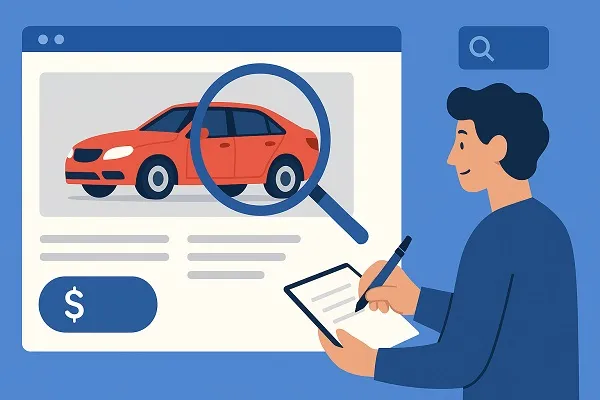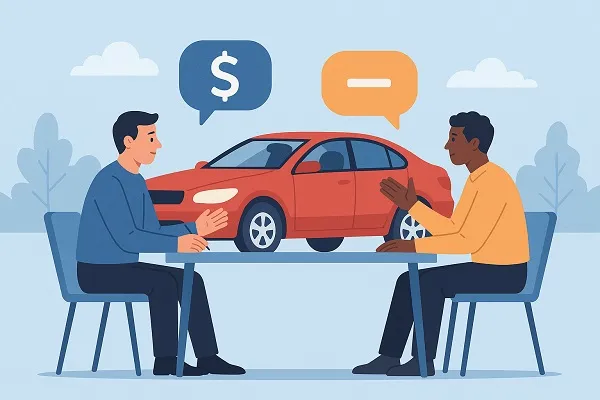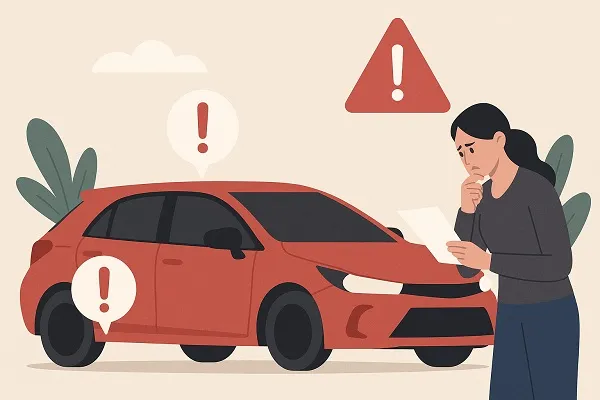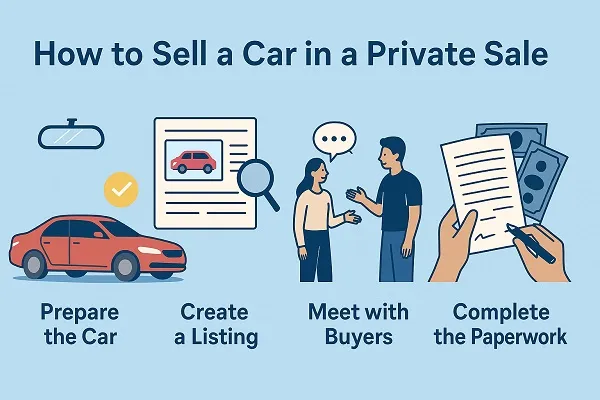Selling a car in a private sale can be one of the best ways to get top dollar for your vehicle. Instead of settling for a lower trade-in value at a dealership, you take control of the process, reach more buyers, and maximize your profit. With the right preparation and knowledge, you can sell your car quickly and safely while avoiding common pitfalls.
Preparing Your Car for Sale
Clean and Detail Thoroughly
A clean car not only looks better but also signals to buyers that it’s been cared for. Before taking photos or showing your car:
- Wash, wax, and polish the exterior for a glossy finish.
- Deep clean the interior, including carpets, seats, and vents.
- Remove personal belongings and clutter.
- Replace air fresheners for a pleasant smell.
Handle Basic Maintenance
Buyers will be wary if they notice obvious issues. Fix affordable problems ahead of time to prevent them from being bargaining chips.
- Replace burned-out bulbs, wipers, or fuses.
- Top off essential fluids.
- Repair minor dents, scratches, or cracked mirrors.
- Consider a pre-sale inspection to show proof of condition.
Setting the Right Price
Your pricing strategy is critical. Set the number too high, and your car will sit unsold. Too low, and you’ll lose money.
Tips for pricing smartly:
- Use tools like Kelley Blue Book, Edmunds, or NADA Guides.
- Browse local listings for cars with the same year, mileage, and trim.
- Factor in extras like leather seats, premium sound systems, or new tires.
- Be realistic about mileage and condition.
A good rule of thumb: price slightly above what you’re willing to accept to leave room for negotiation.
Creating an Effective Listing

Write a Compelling Description
Your listing is your sales pitch. It should be clear, honest, and highlight key features. Include:
- Year, make, model, and trim
- Mileage and fuel type
- Color, transmission type, and drivetrain
- Maintenance records and accident history
- Special upgrades or warranties
Avoid overselling or exaggerating—buyers appreciate transparency.
Use High-Quality Photos
Photos sell cars faster than words. Take at least 15–20 clear images in daylight, including:
- Exterior (front, rear, both sides, and angles)
- Interior (dashboard, seats, trunk, odometer)
- Engine bay and tires
- Any imperfections so buyers know what to expect
Advertising Your Car
The more visibility your listing has, the better your chances of finding the right buyer.
Best platforms to advertise:
- Craigslist and Facebook Marketplace for local buyers
- Autotrader and Cars.com for a wider reach
- Specialty forums if you’re selling a unique model
- Word of mouth—friends, family, and co-workers
Respond quickly to messages and always remain professional in tone.
Handling Buyer Inquiries
Screen Potential Buyers
Not every inquiry is serious. Save time by asking:
- Are they ready to buy soon?
- How will they pay (cash, loan, cashier’s check)?
- Do they want to schedule a test drive quickly?
Arrange Safe Test Drives
Meeting strangers comes with risk. Protect yourself by:
- Meeting in a public, well-lit area (police stations often have safe zones).
- Bringing a friend or family member.
- Holding onto the buyer’s driver’s license during the test drive.
- Setting a specific route to minimize risk.
Negotiating the Sale

Negotiation is where preparation pays off. If you’ve researched pricing and gathered records, you’ll have the confidence to stand firm.
Effective negotiation strategies:
- Stay calm and avoid emotional reactions.
- Highlight maintenance and upgrades to justify your price.
- Know your lowest acceptable number and stick to it.
- Politely decline extreme lowball offers.
Remember: the first offer doesn’t need to be accepted—many buyers expect back-and-forth.
Completing the Paperwork
A successful private car sale isn’t official until the paperwork is done correctly. Typically, you’ll need:
- The signed vehicle title transferring ownership.
- A bill of sale with all details (price, date, signatures).
- A release of liability filed with your state’s DMV.
- A completed odometer disclosure (required in some states).
Check your state’s DMV website for exact requirements.
Securing Payment Safely
Payment scams are common in private car sales, so it’s crucial to handle money safely.
Safe payment methods include:
- Cash – Meet at a bank so the bills can be verified.
- Cashier’s check – Call the issuing bank before handing over the keys.
- Bank transfer – Finalize the sale inside the bank.
Avoid personal checks or wire transfers from unknown sources.
Red Flags to Watch Out For

Selling a car privately can attract scammers. Protect yourself by staying alert for:
- Buyers who refuse to meet in person.
- Requests to ship the car internationally with unusual payment methods.
- Overpayments where they ask you to wire back the difference.
- Buyers who rush the process without seeing the vehicle.
Trust your instincts—if something feels off, walk away.
Tips for Selling Specialty Cars
Selling specialty or unique cars (classic, luxury, or modified vehicles) requires a slightly different approach:
- Advertise on enthusiast forums and niche websites.
- Provide detailed history, including modifications or restorations.
- Get a professional appraisal if unsure of value.
- Expect longer selling times but higher profits.
Common Mistakes to Avoid
Many private sellers lose money or waste time because of avoidable errors. Here are the biggest mistakes:
- Not cleaning the car properly – Dirty cars discourage buyers.
- Overpricing the vehicle – Listings with inflated prices sit unsold.
- Ignoring paperwork requirements – Missing forms can cause legal issues.
- Accepting unsafe payments – Always verify checks or cash.
- Rushing the process – Take your time to find the right buyer.
Selling a car in a private sale takes effort, but the rewards are worth it. By preparing your car, setting a competitive price, creating an honest listing, and staying safe during buyer interactions, you’ll put yourself in the best position to sell quickly and profitably. Avoid common mistakes, watch for red flags, and remember that patience often leads to the best outcome.
Content reviewed and published by Sell My Car Colorado Editorial Team.
